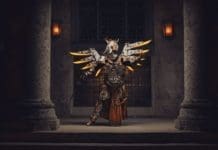A Note from the Author:
The following is a random collection of working notes taken from scores of pages of such notes that I wrote out when I was thinking through The Aylesford Skull. Please be aware that they contain potential spoilers as well as a number of ideas, characters, and potential scenes that didn’t make it into the novel, and so might be puzzling to readers. Hope you find them interesting. Cheers, Jim Blaylock
The Aylesford Skull: Early Character Notes:
CAST:
- LANGDON ST. IVES: The rational man faced with the irrational. He’s become quite fond of Finn Conrad, who’s living on the estate in a cottage. Finn’s disappearance will hit him harder than he knows. It’s Alice who points out why – that’s he’s come to love the boy, but doesn’t know it. Part of the rational man thing. Emotions, human beings, aren’t rational. Can’t quantify them. Emotions surprise him, which amuses her. The things of the heart often leave him confused. St. Ives will save the boy, but ironically, will have to take the boy with him into dusty death and out again in the end, knowing that he’s doing it, and the only silver lining is that if Finn dies, so will St. Ives, and so won’t have to live with the awareness of what he’s done. Also, perhaps no one knows why Finn is on that airship. They’ll wonder why in God’s name he took Finn along.
- THE DEAD BOY: N’s half brother. Appears as a ghost throughout, although never often enough to be silly. You had envisioned him drawing a picture, and that’s okay. It has to be a relevant picture: a portrait of himself being hung by his brother, perhaps. Perhaps a picture of something coming to pass: a Dore-esque vision of the Land of the Dead against a London skyline. That would be good. Looks like nonsense, but then late in the book St. Ives figures it out. How does it work? Partially finished on ghost paper and then more and more fleshed out? Maybe what St. Ives recognizes later (when he’s in the airship) is the “gate” in front of some specific place. This is it! Etc. Thing is, the dead boy drawing is a good thing – could be scary under the right circumstances. If your dead boy vanishes (away with N) or if St. Ives goes away, then his use is minimal: great for the opening scenes, of course, and later as a companion for Finn on the Marshes. It might not be conducive to the drawing thing, though. Maybe he should just write his name in the dirt, or on the wall with a berry. Give some thought to the dead boy.
- FINN CONRAD: the meeting on the road, the kidnapping, his adventures in London, in the sewers, in the Cliffe Marshes, in no particular order. He’s perhaps the one who gets messages back to St. Ives pertaining to the theft/transport of the coal. The machinery, either for powdering or producing coal gas. The steam powered, underground affair in the marsh. Figure out how he gets the first message through to St. Ives, who is mighty relieved. Maybe sneaks out early and meets a mail coach. Pays someone off with stolen money. Maybe a “pair of oars” on a dock in Egypt Bay, who can make good time up to London if the tide’s coming in. “The tide is making. Sure, I can be in the London Docks in no time at all.” Finn might recognize the man as a friend from the Duffy’s circus days, and trust him: pay him in advance. Or he might pay him half now and promise half, but it would mean he’s sure of returning to the dock. Here’s something: Finn is taken by Narbondo, who might have no designs except to deprive St. Ives. No real need for him to be a sacrifice, although the old woman and all the skull talk might give St. Ives that idea. Or maybe that is Narbondo’s plan, but he of course doesn’t reveal it to the boy till they’re in London, post Egypt Bay. In Egypt Bay “Watch the boy. He’s too clever by half. Shoot him if he tries to flee, but by God I want the head. Take these loppers along with you. It must be fresh….” Finn should manipulate Narbondo right there on the road. Says he’s the Professor’s servant. Treated awful. He’d shake him in a cold moment for a fee. (N reacts well to greed.) Enough info so that N foregoes paying the fee and simply grabs him. “Now, cully, you’re a smart lad. Let’s see what you’re made of…” Or something. Finn tries to escape, or threatens to, until the fee is paid. He’s no bond servant. By the time they get to the marshes, he’s pretending to like it well enough. He’s always secretly on the watch, though (and his big break comes when he recognizes old Beanpole Wiggum from the circus). He knows that his days are numbered. Maybe there’s an apple barrel conversation with the Collector, who is promised a fresh lamp – made of Finn’s head. This is good. See “The Collector” below. Finn, then, will avoid death, but will know it’s coming. When they’re back in London, he’ll slip out into the sewers for a big chase scene, in which he’ll see the undertaking. Consider whether he’ll be aboard the airship with St. Ives. You can make that happen. St. Ives would turn back to save the boy, but innumerable deaths…. Stoically goes on with it, Finn co-piloting.
- DR. NARBONDO: His house in London. Waterfront dives. The sewers. Limehouse? The Seven Dials? Right now you’ve got so much going on with Narbondo, that you almost don’t need more. His opening a permanent portal is enough, although it would be nice to figure out why he wants to do this. Maybe for the sake of reputation. Maybe he plans on extorting money from the Crown in return for closing it.
- THE COLLECTOR: We meet him for the first time in the marsh, or at the marsh pub when he’s cutting a deal with N for a skull. “They say you can contrive one.” “Do they?” “Who is it who told you?” (Maybe it’s Merton, and that’s why he’s beaten for opening his trap. Maybe Finn gets a “save poor Merton” message out. That’s why the haste.) Anyway, it’s here that Finn overhears the truth: “I have a boy. Very bright boy. He’ll do, but I need a certain sum…” Thus when St. Ives meets the Collector, he’s not happy. He compels the man to set N up, to deliver the sum, but then is dead. Someone ratted him out to N. “Too many people know” one of our men points out. “That guarantees a surprise, and not a nice one…” “You’ve got the truth of it there, Tubby, but even so, we’ll see this through. It’s our only option.” Below, you’ve got the idea of something similar: St. Ives seeking out a man who used to build infernal devices, but gave it up, arrested but never convicted, then married and had a child, and looks back shamefully. He employs his friend the Knacker to find out whether something’s up, but the Knacker ends up dead. In other words, use both of these, although if you have to pick and choose, the Collector is a better bet, since he’s already a player. Certainly avoid running the same wheeze twice.
- The skull as collector’s item; the Collector again: The skull/lamp is badly wanted by an evil-minded collector of fabulous objects. (This could be an element of any plot, really, although it would change Narbondo’s function in the story.) This Collector might have bought a few of these skulls, or desperately wanted to, just because of their eerie & morbid rarity — but eventually, one way or another, he’s probably going to learn what they can do. Maybe his sister (or mother or lover) died when he was still a relatively uncorrupted young man, and he wants to get her back now, or go to where she is. In other words, the Collector is motivated. Your collector has them sitting around like paperweights – examples, perhaps, from craftsman around the world: Each is a key to a different time and personality. A “library” of skulls/ghosts; a key ring of skulls.
- MERTON: Is a source of information. He knows the Collector, for one thing, and what he collects. He reluctantly tells St. Ives who and where the Collector is, but only after St. Ives reveals that he believes Finn Conrad will be a victim. Merton has some information on the nature of the skull, various oriental examples: a French example, South American, Japanese and the Japanese Magic Mirror connection. He undertakes to buy the coal for N (not, perhaps, knowing who N is) and knows something about the nature of the coal, but is swindled, the coal stolen, the money unpaid. More info re the coal and its whereabouts. He’s either beaten or not beaten. Don’t just have him beaten for the fun of it. Merton stuff is, of course, scattered through the plot notes.
- MOTHER LASWELL: Mother Brisby? Possibly an Edith Nesbitt type. Kraken the late-appearing tugboat. No theatricality (unless you really want to sustain it and make it work, although that’s not difficult if it’s clothes and a cigarette holder and bad poetry) but with socialist leanings. She burns industry out in the yard and the Society is in fact not only green, but is Luddite; maybe their mule is named Ned Ludd. (The Luddites were tried, executed, and deported in 1812 in York, by the way.) Some of her leanings might be conveyed to St. Ives via Kraken. The first time we see her she might be burning industry in the yard. St. Ives is sympathetic to their cause. Alice’s fishing stream is perhaps threatened by the building of some kind of industrial village involving a massive paper mill. You won’t be around the grounds of the Society often, and right now you certainly want a séance. She’s got to be very bothered by N’s return, and that old crime arising again like a specter, and so champagne and cheerfulness as industry burns doesn’t make much sense. That either has to be a very early scene in which she’s confronted with the news of the robbed grave and death of Mary McSwell, or else it’s got to be a third scene in which St. Ives goes back after more information. She doesn’t write poetry (unless her poems are automatic and are messages from the dead). It’s she who makes the Cain and Able reference, the hunch being the mark of Cain. Motive…? All motives: jealousy, greed, but simply because he’s a son of a bitch. Talk about a materialist. Etc. She tells the story of what happened. She knows who robbed the grave, and who murdered poor Nell. And now God knows what’ll happen – the grave a Pandora’s Box, but without Hope. St. Ives is going to have to undertake that job. Maybe Kraken points this out, and St. Ives looks suddenly tired. “Oh, there’s hope, Mother, he’s a-sitting right there!” She points out that “Narbondo is not his name, but something he found in an old book. He set up to model himself after monsters. That was his choice after all, and that’s maybe the hardest to take: why? What was broken inside him? When did it break? “I won’t utter his true name. If I knew it was my doing, I’d cut off my hand.” She and Merton are both good sources of information. She might appear later in London or in Cliffe. She wants the skull back, and she means to get it. She sees herself as responsible. She had thought she was quit of it all those years ago, but how he returns, pede claudo, like the ghost at the feast. (That was in J and H, by the way.) St. Ives: “Is it possible that the ghost of the old sin has come back around to haunt us?” Mother Laswell: “It’s no ghost, it’s the sin itself in the person of my son.”
- ALICE: Could be St. Ives’s sounding board during the time in North Kent. You don’t need to haul Jack Owlesby up there. Remember that Hasbro is there, also. You’ve got three people on the case, then.
- JACK OWLESBY: Right now, I say leave Owlesby out of it at least till you get up to London. If you want, have Owlesby just married to Dorothy and the two of them traveling on the continent. Don’t use him at all. Focus on St. Ives, Hasbro, Alice, N, Finn, and maybe haul in Tubby. Consider this at least. In short, don’t load this up with familiar faces merely because they’re familiar. On the other hand, Jack has been a staple in all other stories, so leaving him out is odd. Figure out how to use him, but don’t have him appear before he’s useful, and the same, of course, goes for Tubby, Gilbert, etc. St. Ives will get up to London soon enough. That’s when we’ll add characters. Lot of stuff going on in London, actually: you might need the Trismegistus Club, who knows? Vital that you remember that by now Jack and Dorothy are an item, that thereare children to be considered, etc.
- MARY McSWELL: Shot and pushed into the grave early on. Now a woman, she has always been close to Mother Laswell, maybe a member of the society, maybe living on the property. Finn might see something: N wearing a woman’s scarf around his wrist, like a trophy. (Check out what Lancelot’s give from Elaine was called.) Alice understands this almost at once. St. Ives (after N has flown) asks about the scarf, and the old lady identifies it, although without a better, more exacting description from Finn, who didn’t pay it no mind, really, there’s no saying for sure. N had the wild idea that she’d accept him now. He had money, power. He could give her things, show her things. She spit in his eye. This, of course, in the prologue, which is objective.
- THE SOCIETY OF PSYCHICS: Check your notes, whether you want a facsimile of the Fox Sisters (only two of them, with their own disorder) or Lombroso’s elbow-listening girl, or both. Most of the people who live there are maybe believers, but who cares? All are loyal to Mother Laswell. The question is what to do with them. They can’t all participate. One might – the deaf girl, say, but what’s the point? She might accompany Mother Laswell to London or Cliffe. Still and all, what’s the point? She’s going to carry on a conversation with Finn through her elbow? What if she can commune with the dead boy? What if she, like Finn, can sense his presence? She’d be handy then. She’d be able to track the skull like a watchdog sniffing out a criminal.
- CESARE LOMBROSO: Maybe, but only if he’s useful. Remember that small time luminaries don’t ring the public’s bell. If you want there to be someone actively looking into the mental health of one of the people at the Society, then fine: he could be full of St. Ives’s doubt, or had been, but now… He needs to contribute something re the plot, though.Famously, in 1882 he was called in to examine the peculiar behavior of a fourteen year-old girl, who was the daughter of a prominent Italian family. She had developed various hysterical symptoms (some reminiscent of the girl in The Exorcist): causeless convulsions, projectile vomiting, recurring paralysis, enormous and sudden muscular energy, hysterical blindness, etc. And, most interestingly, common veridical hallucinations: crisis apparitions. Her parents were beside themselves. At night she would sleepwalk, and despite her apparent blindness would work like a maniac in the house, cleaning things up with tremendous energy. She also revealed an extraordinary musical talent, which her parents were surprised at. She was exceedingly affectionate during these somnambulistic wanderings, expressing great love for her parents and even for Lombroso. As time went on, she began to exhibit what Lombroso called a “masculine boldness and a lack of moral principle.” Lombroso became convinced that she in fact was not seeing with her eyes – that she was hysterically blind. There was the possibility, of course, that she herself was convinced that she was blind (the blindness had no physical cause) but that when she was sleepwalking she did in fact see. In other words, she deceived herself when she was awake but not when she was asleep. Lombroso decided to find out. He bandaged her eyes securely, and it made no difference. She could still “see.” Lombroso had her read out loud a letter that had just come by mail, and which he had just then opened up. She read it straight out, but only when he held it in front of her nose or beside the lobe of her left ear.
- UNCLE GILBERT FROBISHER: He’s got the steam yacht in Eastbourne, and easy swing around into the channel, up the Thames and into Egypt Bay for the birding. He’s all set up in an elaborate bivouac. Useful if they’re going to beard the pirates and/or land in the environs of the smugglers. He might also have access to an airship. He’s fabulously wealthy. An airship is your man for the marshes and also for the final scene. Gilbert perhaps wants to go along, as does Finn. Maybe both of them, but Gilbert probably shouldn’t. The final scene, which is one of regret for St. Ives, should be St. Ives and the boy. He’s probably got a birding friend and his manservant and manservant’s wife.
- BILL KRAKEN: St. Ives finds him in the barn, an apparition. He’s seen the boy’s ghost in the barn, which has just this moment vanished, and he turns around to see Bill Kraken. Another ghost? “Feel of me.” The bit out of the Bible. Kraken will resume his old role, wandering in London if need be. His paranormal powers will be useful. He’ll “see” things with his elbow or ear, maybe. Why not? Why not Kraken? He can see spirits. He knows when there’s a “current” running through the spirit world – a disturbance, etc. All of this is good.
POTENTIALLY USEFUL CHARACTERS:
- THE BILLSONS: The ghosts on the fog are in the environs of the Half Toad. Also, St. Ives will stay there when he comes into London. The thing is, you’ve established that Billson keeps aquaria, so it makes no sense that St. Ives wouldn’t look into them. The aquaria, though, should be the stuff of another book, because they don’t and can’t figure here. It could be you want to show only the working side of the Half Toad and save the odd side for a novella. The octopus suggests itself: Billson has connections in the fish trade. In the end, however, since the Billsons aren’t needed, you could simply put St. Ives somewhere else: you could make a place up, or you could use the back room of the cigar divan, or whatever. Right now your idea is to omit or largely omit the Billsons in order to avoid the tone problem. Or… you might, like Dickens, want an array of characters.
- There’s mention in Wikepedia of a FAMOUS ARCHEOLOGIST who lived and died in Strood, Kent. He’d have been in his 70s during this book. Do we want his opinion of the coal/Neolithic ruins/etc.?
- Also, a FAMOUS BOTANIST/artist in Strood. Friend of Alice’s? Part of the Alice Society? Remember that none of these folks are recognizable. Simply adding her in because she happened to have lived nearby is sketchy. She might be injured if you’re actually going to start out with the Bayswater Club conservatory exploded. Still… Check the article to make sure the date is right and how old she’d be. She might run into Alice in the woods when Alice is fishing and identify N.
- WILFRED KEEBLE; Jack is learning the toy trade currently, so Keeble might easily figure in some way, although you don’t need superfluous characters. They might consult him about the skull, and he could mention the Collector, leaving Merton to the coal. Keeble might have built a prototype airship engine running on a battery, which will be the airship used in the end.
- WILLIS PULE and his mother (Pule is loony): Why would Narbondo keep a loony Pule around? Pule can’t be found dead in the hole, because he’s alive in ’85. Nice to know where he is in the mean time. Also, Pule is good in H because we know him, and because N needed a sidekick. Now we don’t know him. If you don’t need him, don’t shoehorn him in. Right now he’s probably in Bedlam. On the other hand, if he’s living with his mother in Cliffe Marsh, running the infamous inn, replete with floating severed head, then he can give Uncle Gilbert fits. His mother would be a nice addition to N’s gang.
- MRS LANGLEY, the housekeeper (will come along with the Harrogate/North Yorkshire house post ’82). She can take care of the children in the event that Alice plays her part.
- PARSONS, secretary of the Royal Academy of Sciences. (Should be a thorn in St. Ives’s side pre-‘85, since you say he is in L.K.’s Machine, which is ’85. He’s good to go into the ‘90s.) If N intends to blow up the Bayswater Club, then Parsons is a natural player.
- THEOPHILUS GODALL and the Cigar Divan (if you want him. What’s the point, though? Make sure there’s a point. Don’t just wedge him in. Leave him to his Cigar Divan for the moment.)
- CAPTAIN POWERS (By now married to Nell Owlesby) Only if the Trismegistus Club is functioning in the Cigar Divan. But the smoking leg thing really won’t fly, and the joke’s no longer relevant, so no. Sans the pipe-leg, then maybe, since he’s married to Jack’s mother. On the other hand, these characters are alive and well somewhere, let them live in peace.
- SAM BURKE and THE TIPPER (henchmen from The Madness Ray) Why? Are they more useful than any other henchmen? The Peddler was interesting before because of the scene in Victoria Station. Can you find something equally interesting about him? Perhaps he appears to the Collector or to Merton or someone. Probably he’s involved in the murder of the Collector. Remember that Finn Conrad doesn’t know who these two are. The Tipper is maybe more immediately useful. In any event, why aren’t these two in jail? They were arrested a year ago.
- NELL OWLESBY, Jack’s mother. It would in fact be weird if she were never mentioned, since she figures into H. However, figure out something good, and, again, just because she’s living in London, there’s no reason that she has to pick up the cudgels here.
This article was posted as part of the Aylesford Skull Swashbuckling Blog Tour celebrating the release of James P. Blaylock’s first full-length steampunk novel in twenty years. For the opportunity to win a limited edition of The Aylesford Skull in a jacketed, signed hardcover with a unique jacket design, just tweet “I would like a limited edition of the Aylesford Skull @TitanBooks #Blaylock”.
Details about The Limited Edition (available Feb 2013)
- 750 signed and numbered editions:
- Jacketed, cloth-bound hardcover with ribbon
- Signed by James P. Blaylock
- Exclusive foreword by K.W. Jeter and introduction by Tim Powers
- 26 signed and lettered editions:
- As above encased in a custom-made traycase
Be the first to find out when The Aylesford Skull (Limited Edition) is available, by signing up to our mailing list here: http://www.titanbooks.
[SlideDeck2 id=9535]
he/him • aapi • intj • geek • photographer • journalist • podcaster • martial artist • foodie • dj • cinephile • gamer • traveler































